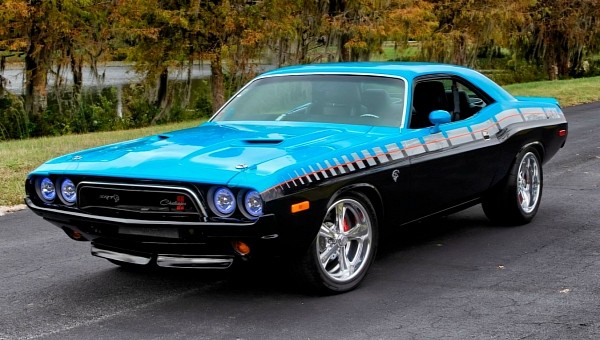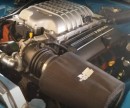Introduced in 1970, the Dodge Challenger arrived a bit late to the muscle car party. By 1972, Chrysler discontinued both the 440-cubic-inch (7.2-liter) RB and the 426-cubic-inch (7.0-liter) HEMI V8s, a move that turned the Challenger into a more mundane coupe. By 1973, the pony was barely making 240 horsepower.
As a result, first-generation Challengers built after the 1971 model year aren't as desirable as their predecessors. They're also a lot more affordable to buy, even when we're talking about rotisserie-type restorations. And this prompted many enthusiasts to drop original HEMI V8 mills into 1972-to-1974 Chargers.
I showed one such project in November 2022, in the form of a finely restored 1973 Challenger stuffed with a modern third-generation HEMI. While not a vintage powerplant, it did have 426-style valve covers and an air filter, so it looked quite authentic. Well, here's another 1973 example that's been given a proper high-performance V8, also of the modern variety.
But even though it sports a funky livery with "HEMI" lettering on the rear fenders, this Challenger does not draw juice from a vintage 426 or a Gen III HEMI. Instead, it packs a supercharged Hellcat V8 under its unassuming hood. Yup, it's a 6.2-liter crate engine and delivers a whopping 720 horsepower to the rear wheels. That's notably more than a full-blown HEMI Challenger from the muscle car era, which was factory rated at 425 horsepower.
The mill mates to a custom-built Gearstar transmission that can take up to 850 horsepower and spins the wheels through a nine-inch rear end supplied by Eaton. A pair of 305/35R18 drag radials provide the necessary grip to get this monster going when the pedal hits the metal.
The Challenger also has the cool looks it needs to stand out at the local street rod meeting. Sporting a bright blue top and a black bottom, the Mopar also has a red stripe running along the belt line and white graphics that harken back to the 1970 Plymouth AAR 'Cuda. Yes, I know it's not a Challenger, but these cars had a lot in common. Dodge also built its own version of the AAR 'Cuda; it was called the Challenger T/A.
The interior is even more radical than the exterior because it no longer has too much in common with the 1973 Challenger. The builder opted to transplant a Challenger Hellcat interior, so this classic now features modern bucket seats for enhanced comfort and lateral support.
Other enhancements include a Flaming River steering wheel and column, Dakota Digital gauges, and faux carbon-fiber trim on the dashboard. The latter looks surprisingly accurate if you don;'t get very close.
So what's the deal with this somewhat unusual build? Well, it was found by YouTube's "Wags Automotive" sitting pretty at Kissimmee 2023. That's where Mecum Auctions sold off quite a few muscle cars, including more than a dozen Dodge Charger Daytonas and Plymouth Superbirds.
This custom Challenger also went under the hammer, but the auction came to a halt at $100,000 and got a "bid goes on..." status. This basically means that the car didn't sell while it was on the block but potential buyers can still get it by making a deal with the owner. But regardless on whether it changes hands or not, it's one of the coolest 1973 Challenger restomods out there. Check it out in the video below.
I showed one such project in November 2022, in the form of a finely restored 1973 Challenger stuffed with a modern third-generation HEMI. While not a vintage powerplant, it did have 426-style valve covers and an air filter, so it looked quite authentic. Well, here's another 1973 example that's been given a proper high-performance V8, also of the modern variety.
But even though it sports a funky livery with "HEMI" lettering on the rear fenders, this Challenger does not draw juice from a vintage 426 or a Gen III HEMI. Instead, it packs a supercharged Hellcat V8 under its unassuming hood. Yup, it's a 6.2-liter crate engine and delivers a whopping 720 horsepower to the rear wheels. That's notably more than a full-blown HEMI Challenger from the muscle car era, which was factory rated at 425 horsepower.
The mill mates to a custom-built Gearstar transmission that can take up to 850 horsepower and spins the wheels through a nine-inch rear end supplied by Eaton. A pair of 305/35R18 drag radials provide the necessary grip to get this monster going when the pedal hits the metal.
The Challenger also has the cool looks it needs to stand out at the local street rod meeting. Sporting a bright blue top and a black bottom, the Mopar also has a red stripe running along the belt line and white graphics that harken back to the 1970 Plymouth AAR 'Cuda. Yes, I know it's not a Challenger, but these cars had a lot in common. Dodge also built its own version of the AAR 'Cuda; it was called the Challenger T/A.
The interior is even more radical than the exterior because it no longer has too much in common with the 1973 Challenger. The builder opted to transplant a Challenger Hellcat interior, so this classic now features modern bucket seats for enhanced comfort and lateral support.
Other enhancements include a Flaming River steering wheel and column, Dakota Digital gauges, and faux carbon-fiber trim on the dashboard. The latter looks surprisingly accurate if you don;'t get very close.
So what's the deal with this somewhat unusual build? Well, it was found by YouTube's "Wags Automotive" sitting pretty at Kissimmee 2023. That's where Mecum Auctions sold off quite a few muscle cars, including more than a dozen Dodge Charger Daytonas and Plymouth Superbirds.
This custom Challenger also went under the hammer, but the auction came to a halt at $100,000 and got a "bid goes on..." status. This basically means that the car didn't sell while it was on the block but potential buyers can still get it by making a deal with the owner. But regardless on whether it changes hands or not, it's one of the coolest 1973 Challenger restomods out there. Check it out in the video below.













